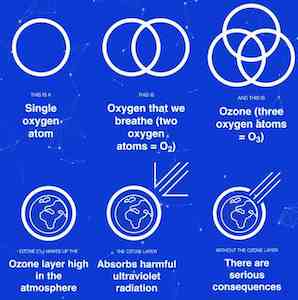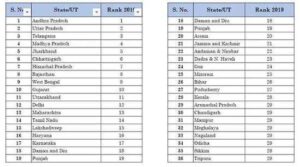Low ozone over Brahmaputra River Valley, A National Biopharma Mission supported Facility, Start-Up Village Entrepreneurship Programme (SVEP), State rankings on implementation of Business Reform Action Plan for the year 2019
- Posted by Param IAS Team
- Categories Daily News
- Date September 6, 2020
Low ozone over Brahmaputra River Valley

- Researchers have found that the concentration of near surface ozone in this region in the North-East corner of India is low compared to the other urban locations in India.
- Scientists at the Aryabhatta Research Institute of Observational Sciences (ARIES), Nainital an autonomous research institute under the Department of Science and Technology (DST) Govt. of India have evaluated the near surface ozone in the Brahmaputra River Valley (BRV) and found relatively low concentration of Ozone over Guwahati compared to the other urban locations in India.
- Their present work has been published recently in the journal ‘Atmospheric Pollution Research’.
- It is good news for the Brahmaputra River Valley (BRV).
- Tropospheric, or ground-level ozone, is created by chemical reactions between oxides of nitrogen (NOx) and volatile organic compounds (VOC).
- It usually increases when pollutants emitted by cars, power plants, industrial boilers, refineries, chemical plants, and other sources chemically react in the presence of sunlight, impacting human health.
- It also assessed seasonal, day of week, and characteristics of ozone to identify the emission source of ozone and its precursors, especially methane (CH4) and NMHCs, along with study the relationships between the meteorological parameters, ozone and its precursors in a tropical setting.
- The examination of nitric oxide, nitrogen dioxide, and ozone concentrations in this study suggested that this site is well influenced by local sources such as adjacent major national highway.
- During the daylight hours, the site is in or nearly in a photo-stationary state, indicating a low impact of organic species on the ozone concentrations.
- As we know Ozone is produced naturally in the stratosphere due to photolysis.
- Photolysis is a process when highly energetic solar radiation strikes molecules of oxygen and because of this reaction the two oxygen atoms split apart.
A National Biopharma Mission supported Facility
- Department of Biotechnology, Government of India has taken myriads of initiatives to increase investments in research and development (R&D) of affordable Biotech healthcare products.
- Establishment of National Biopharma Mission is one such endeavour to identify the needs and gaps of Biotherapeutics, Vaccine and Devices Industry and address those capacity bottlenecks.
- National Immunogenicity & Biologics Evaluation Center (NIBEC) for assessing clinical Immunogenicity of viral vaccines is established jointly by Bharati Vidyapeeth University through its constituent unit Interactive Research School for Health Affairs (IRSHA) and BIRAC-DBT, Government of India through National Biopharma Mission.
About National Biopharma Mission:
- The Industry-Academia Collaborative Mission of Department of Biotechnology (DBT), Govt of India for accelerating discovery research to early development for Biopharmaceuticals approved by the Cabinet for a total cost US$ 250 million and 50% co-funded by the World Bank is being implemented at Biotechnology Research Assistance Council (BIRAC).
- This program is dedicated to deliver affordable products to the nation with an aim to improve the health standards of India’s population.
- Vaccines, medical devices and diagnostics and biotherapeutics are few of its most important domains, besides, strengthening the clinical trial capacity and building technology transfer capabilities in the country.
About IRSHA:
- Interactive Research School for Health Affairs (IRSHA) is a unique constituent unit of Bharati Vidyapeeth (Deemed to be University), totally dedicated to research.
- The institute was established in 2001.
- The institute is mandated to conduct research in priority areas of human health in co-ordination with other constituents of the university like Medical, Ayurveda, Homeopathy, Dental colleges, Rajiv Gandhi Institute of IT & BT, Environmental sciences etc.
- The core area of research includes Mother and child health, Cancer, Diabetes, Obesity, Osteoarthritis & Herbal medicine.
About BIRAC: Biotechnology Industry Research Assistance Council (BIRAC) is a not-for-profit Section 8, Schedule B, Public Sector Enterprise, set up by Department of Biotechnology (DBT), Government of India as an Interface Agency to strengthen and empower the emerging Biotech enterprise to undertake strategic research and innovation, addressing nationally relevant product development needs.
About DBT: The Department of Biotechnology (DBT), under the Ministry of Science & Technology, promotes and accelerates the development of biotechnology in India, including growth and application of biotechnology in the areas of agriculture, healthcare, animal sciences, environment and industry.
Start-Up Village Entrepreneurship Programme (SVEP)
- Start-Up Village Entrepreneurship Programme (SVEP) is implemented by Deendayal Antyodaya Yojana –National Rural Livelihoods Mission (DAY-NRLM), Ministry of Rural Development, as a sub-scheme since 2016.
- With an objective to support the rural poor come out of poverty, supporting them setup enterprises and provide support till the enterprises stabilize, SVEP focusses on providing self-employment opportunities with financial assistance and training in business management and soft skills while creating local community cadres for promotion of enterprises.
- SVEP addresses three major pillars of rural start-ups namely – finances, incubation and skill ecosystems.
- One of the key areas is to develop pool of community resource persons – enterprise promotion (CRP-EP) who are local and support entrepreneurs setting-up rural enterprises.
- Another key area is to promote the block resource center (BRC) in SVEP blocks, to monitor and manage the community resource persons, appraise SVEP loan application and acts as the repository of enterprise related information in the concern block. BRCs play the role to support sustainable revenue model to operate effectively and independently.
- During the initial years of implementation, the SVEP focused on mobilizing rural communities to setup and strengthen the institution structures, invest on training and capacity building on business management aspects for the BRC members, created pool of CRP-EPs and provided them intensive training, supported the entrepreneurs to scale up their existing enterprises as well as establish and support the new enterprises.
- Over the years the SVEP has made an impressive progress and has extended business support services and capital infusion to 153 blocks of 23 states as of August 2020.
- A mid-term review of SVEP which was conducted in September 2019 by Quality Council of India shows about 82% of the sampled entrepreneurs across the blocks reported being from SC, ST and OBC categories which signifies social inclusion – one of the pillars of NRLM.
- 75% of the enterprises were owned and managed by women and average monthly revenue of enterprises was Rs.39,000 – Rs.47,800 in case of manufacturing, Rs.41,700 in case of services and Rs.36,000 in case of trading.
- The study also shows that about 57% of the total household income of the entrepreneurs is through SVEP enterprises.
- SVEP promotes both individual and group enterprises, set-up and promote enterprises majorly on manufacturing, trading and service sectors.
- The program invested largely on building the capacities of the entrepreneurs to run the businesses profitably based on the local demand and eco-system.
- The CRP-EPs are certified and provides business support services to the entrepreneurs.
- Investments are also made under SVEP on use of ICT to create standard E-learning modules for minimizing the transmission loss in technical aspects like business plan and profit and loss account preparations.
State rankings on implementation of Business Reform Action Plan for the year 2019

- Ranking of States based on the implementation of Business Reform Action Plan started in the year 2015.
- State Rankings have been released for the years 2015, 2016 and 2017-18 till date.
- The Business Reform Action Plan 2018-19 includes 180 reform points covering 12 business regulatory areas such as Access to Information, Single Window System, Labour, Environment, etc.
- The larger objective of attracting investments and increasing Ease of Doing Business in each State was sought to be achieved by introducing an element of healthy competition through a system of ranking states based on their performance in the implementation of Business Reform Action Plan.
- The ranking this time gives full weightage to the feedback from over thirty thousand respondents at the ground level, who gave their opinion about the effectiveness of the reforms.
- State rankings will help attract investments, foster healthy competition and increase Ease of Doing Business in each State.
- India is seen taking the reform process seriously which showed when foreign direct investment in the country increased even during the Covid-19 pandemic, amid what was called world’s strictest lockdown.
- Some states have shown extraordinary energy in putting together action plans and making sure that reforms happen.
- States have embraced the true spirit behind the State Business Reforms Action Plan.
- The Ease of Doing Business rankings being released today are a reflection of the efforts made by states, the rankings are competitive.
- India is among the very few nations which has state-specific rankings, which will in turn help the nation improve its ranking.
The top ten states under State Reform Action Plan 2019 are:
- Andhra Pradesh
- Uttar Pradesh
- Telangana
- Madhya Pradesh
- Jharkhand
- Chhattisgarh
- Himachal Pradesh
- Rajasthan
- West Bengal
- Gujarat
"Start where you are. Use what you have. Do what you can."
"The secret of success is to do the common things uncommonly well."
"Good things come to people who wait, but better things come to those who go out and get them."
"Success is the sum of small efforts, repeated day in and day out."
Read, Read, and .....Read..
You may also like
Union Budget 2021-22
Union Budget 2021-22 The budget for the year 2021 has been presented amidst exceptional circumstances. Today’s Budget contains a vision of self-reliance as well as inclusiveness for every individual and class. The budget has principles of new opportunities for growth, …
Foster digital literacy and accelerate the India startup ecosystem with Atal Incubation Centers Atal Innovation Mission (AIM), NITI Aayog and SAP Labs India have strengthened their partnership to promote digital literacy, innovation and entrepreneurship in India. As part of the …
Indo-Nepal Link Canal, 260TH ARMY SERVICE CORPS DAY
Indo-Nepal Link Canal India’s premier hydropower company and a PSU under Ministry of Power, laid the foundation stone of head regulator works of Indo-Nepal Link Canal at Barrage of 94.2 MW Tanakpur Power Station of NHPC located in Banbasa, Distt. …
